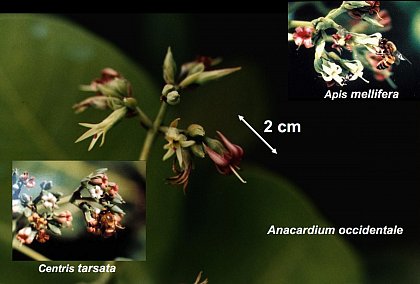Pollination
That bees are major pollinators of Angiosperms is well recognised. However, the extent to which a flower visitor effects pollination is unclear. We are interested in quantifying the role of different flower visitors in pollination, particularly focusing on the rural to urban transition and, in terms of applied interest, on apple (Malus domestica), an important crop plant. On-going field research is located in and around Halle, as part of an ESCALATE funded project and part of an iDiv funded project. We place strong emphasis on an experimental approach to quantify the role of different flower visitors in pollination of specific crops or wild plants.

In its native Brazil, flowers of cashew (Anacardium occidentale) are visited and pollinated by indigenous bees (Centris tarsata, left) and the introduced honey bee (Apis mellifera, right)
Key references
Osterman, J., Theodorou, P., Radzevičiūtė, R., Schnitker, P., & Paxton, R. J. (2021). Apple pollination is ensured by wild bees when honey bees are drawn away from orchards by a mass co-flowering crop, oilseed rape. Agriculture, Ecosystems & Environment, 315, 107383. doi:10.1016/J.AGEE.2021.107383
Radzevičiūtė, R. , Theodorou, P., Schlegel, M., & Paxton, R. J. (2021). A two-part modelling approach reveals a positive effect of pollinator biodiversity in boosting the pollination of apple flowers. Agriculture, Ecosystems & Environment, 306, 107197. doi:10.1016/J.AGEE.2020.107197
Landaverde-González, P., Quezada-Euán, J.J.G., Theodorou, P., Murray, T.E., Husemann, M., Ayala, R., Moo-Valle, H., Vandame, R. & Paxton, R.J. 2017. Sweat bees on hot chillies: provision of pollination services by native bees in traditional slash-and-burn agriculture in the Yucatán Peninsula of tropical Mexico. Journal of Applied Ecology 54, 1814-1824. DOI: 10.1111/1365-2664.12860
Theodorou, P., Albig, K., Radzevičiūtė, R., Settele, J., Schweiger, O., Murray, T.E. & Paxton, R.J. 2017. The structure of flower visitor networks in relation to pollination across an agricultural to urban gradient. Functional Ecology 31, 838-847. DOI: 10.1111/1365-2435.12803
Theodorou, P., Radzevičiūtė, R., Settele, J., Schweiger, O., Murray, T.E. & Paxton, R.J. 2016. Pollination services enhanced with urbanization despite increasing pollinator parasitism. Proceedings of the Royal Society of London B: Biological Sciences 283: 20160561. doi: 10.1098/rspb.2016.0561
Freitas, B.M. & Paxton, R.J. 1998. A comparison of two pollinators: the introduced honey bee (Apis mellifera) and an indigenous bee (Centris tarsata) on cashew (Anacardium occidentale) in its native range of NE Brazil. Journal of Applied Ecology 35, 109-121. DOI: 10.1046/j.1365-2664.1998.00278.x
Our principal overseas collaborators
Prof. Dr. Josef Settele , UFZ
Dr. Oliver Schweiger , UFZ
Prof. Javier Quezada , Autonomous University of Yucatan



